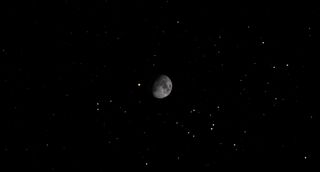Watch the Moon Blot Out Bright Star Aldebaran Tuesday

As the moon orbits Earth, the satellite regularly passes in front of stars, causing events known as lunar occultations.
Most of the stars involved are faint and require a telescope to see, but there are a few really bright stars in the moon's path, including Regulus, Spica, Antares and Aldebaran, whose occultation can be observed with the unaided eye.
One such occultation occurs on Tuesday (Jan. 19), when the moon passes in front of the red-giant star Aldebaran. This event will be visible to observers all over North America, as well as in Hawaii and western Europe. [January's Night Sky: Planets, Giant Stars and More (Video)]
Because the moon has no significant atmosphere, stars passing behind it appear to wink out instantaneously, as if someone turned them off with a switch. In fact, this was how we first learned that the moon was an airless world. The effect is particularly spectacular when the star is really bright, like Aldebaran.
The only exception to this instantaneous disappearance is when the star appears to approach the moon at a shallow angle in what is called a grazing occultation. In this case, the star may briefly reappear, if it passes behind a valley on the limb of the moon.
The exact time of Tuesday's occultation will depend on your location, because the moon is relatively close to us and exhibits parallax — like what you see when you hold your finger up in front of a distant landscape. Calculating these times used to be very complicated, but with modern planetarium software like Starry Night and SkySafari, all the hard work is done for you.
Simply set the software to your location and to an enlarged view of the moon for Tuesday evening, and note the times when Aldebaran disappears and reappears. Example times for New York are 9:31 p.m. EST for the disappearance and 10:43 p.m. EST for the reappearance; for Los Angeles, the times are 5:03 p.m. PST and 6:14 p.m. PST.
Get the Space.com Newsletter
Breaking space news, the latest updates on rocket launches, skywatching events and more!
Since Aldebaran is a first-magnitude star, it can be easily seen with the naked eye, even in the city, though its light will be somewhat dimmed by the gibbous moon. A small telescope or binoculars will improve its visibility enormously.
Amateur astronomers used to make accurate timings of lunar occultations to help map the details along the edge of the moon, but this work has become less important now that we have other ways of mapping the moon. But it is still a worthwhile observation for any skywatcher to see the huge body of the moon slowly move in front of background stars.
Since Aldebaran sits right in front of the Hyades star cluster, if you watch the moon with a telescope for an hour or so before the main event, you will see it occult several other dimmer stars.
Tuesday's event is part of a series of occultations of Aldebaran that can be seen somewhere in the world every month this year except June.
Editor's note: If you capture a great photo of the moon or any other night-sky sight and want to share it with us and our news partners for a story or gallery, we want to know. Send your images and comments in to: spacephotos@space.com.
This article was provided to Space.com by Simulation Curriculum, the leader in space science curriculum solutions and the makers of Starry Night and SkySafari. Follow Starry Night on Twitter @StarryNightEdu. Follow us @Spacedotcom, Facebook and Google+. Original article on Space.com.
Join our Space Forums to keep talking space on the latest missions, night sky and more! And if you have a news tip, correction or comment, let us know at: community@space.com.

Geoff Gaherty was Space.com's Night Sky columnist and in partnership with Starry Night software and a dedicated amateur astronomer who sought to share the wonders of the night sky with the world. Based in Canada, Geoff studied mathematics and physics at McGill University and earned a Ph.D. in anthropology from the University of Toronto, all while pursuing a passion for the night sky and serving as an astronomy communicator. He credited a partial solar eclipse observed in 1946 (at age 5) and his 1957 sighting of the Comet Arend-Roland as a teenager for sparking his interest in amateur astronomy. In 2008, Geoff won the Chant Medal from the Royal Astronomical Society of Canada, an award given to a Canadian amateur astronomer in recognition of their lifetime achievements. Sadly, Geoff passed away July 7, 2016 due to complications from a kidney transplant, but his legacy continues at Starry Night.

